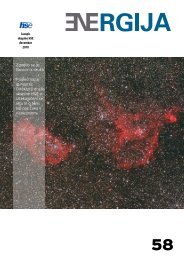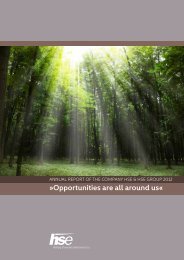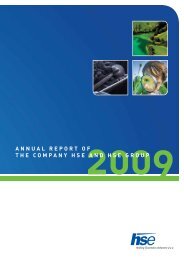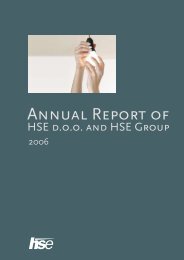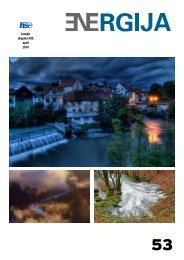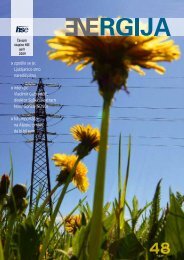ANNUAL REPORT - HSE
ANNUAL REPORT - HSE
ANNUAL REPORT - HSE
Create successful ePaper yourself
Turn your PDF publications into a flip-book with our unique Google optimized e-Paper software.
Annual inflation in %<br />
price movements were characterised chiefly by lower<br />
prices of liquid fuels resulting from a downward trend<br />
in oil prices on the global markets. In addition to the<br />
lower prices of raw materials, the decrease in inflation<br />
was also influenced by subsided economic activity and<br />
expectations. The same reasons lead to a continued<br />
slowdown in inflation in the entire euro area, where it<br />
equalled 1.6% in December.<br />
Negative net balance of the<br />
national budget<br />
At the end of 2008, the Slovene national budget recorded<br />
a negative net position compared to the EU<br />
budget in the amount of € 64.7 million. As a result of<br />
new statistical aggregate estimates, total payments to<br />
the EU budget in 2008 exceeded the funds allocated<br />
for this purpose in the scope of the 2008 budget by<br />
almost 10%, whereas less than half the funds were<br />
drawn (44.4%).<br />
Inflation movement in Slovenia<br />
and the euro area in the<br />
2000–2008 period 2<br />
12<br />
10<br />
8<br />
6<br />
4<br />
2<br />
0<br />
Jan 00<br />
Jan 01<br />
Slovenia<br />
Jan 02<br />
Euro area<br />
Jan 03<br />
The movements on the international financial markets<br />
had a strong impact also on domestic exchange movements,<br />
as the SBI20 index dropped by nearly 70%. The<br />
index thus reached the lowest level since 2003. According<br />
to the exchange rate as at 31 December 2008,<br />
1 euro equalled 1.2591 US dollars.<br />
Another significant event occurring in the energy sector<br />
in 2008 was without a doubt the gas crisis, origi-<br />
2<br />
Source: SORS, EUROSTAT<br />
Jan 04<br />
Jan 05<br />
Jan 06<br />
Jan 07<br />
Jan 08<br />
Jan 09<br />
nating from the dispute between Russia and Ukraine.<br />
The crisis demonstrated the importance of domestic<br />
energy products for energy supply.<br />
In the past year, electricity production grew considerably<br />
(+9.7%), whereas consumption decreased<br />
(–5.4%). Net electricity export rose, accounting for<br />
10.6% of total electricity consumption, which was the<br />
highest figure since 2001.<br />
2.6.2 Market environment<br />
of the electricity industry<br />
In the past year, the market environment of the electricity<br />
industry was hugely characterised by extensive<br />
electricity price changes. The major reasons for the<br />
situation at hand should be sought in the global economic<br />
conditions and the international financial crisis,<br />
which towards the end of the year evolved into a general<br />
economic crisis. The altered economic conditions were<br />
greatly reflected in the prices of primary energy products<br />
such as oil, coal and natural gas, and consequently<br />
also in the prices of electricity. Until mid 2008 we recorded<br />
high growth in the prices of energy products and<br />
thus in the prices of electricity, however, in the second<br />
half of the year the situation was substantially different.<br />
Prices started plummeting from the record levels, and<br />
still experienced a downward trend at the end of 2008.<br />
According to the European directive on the crossborder<br />
transmission capacity allocation, the Slovene<br />
transmission network operator in 2008 continued allocating<br />
its cross-border transmission capacities at<br />
the Slovene borders on a market basis.<br />
One of the major factors greatly influencing the electricity<br />
market is the emission coupon market. In 2008<br />
we entered a new five-year Kyoto period, lasting until<br />
2012, during which an even greater focus on the reduction<br />
of greenhouse gas emissions is projected. The<br />
number of emission coupons allocated for this period<br />
points to the fact that the protocol signatories are<br />
striving to prevent the pre-Kyoto situation from recurring.<br />
Namely, in the last year of the 2005¬–2007 period<br />
it became clear that there had been too many coupons<br />
distributed. This was reflected in their price. In 2008<br />
the coupon price mimicked energy product prices – oil<br />
in particular, which means that prices slumped in the<br />
second half of 2008. Nevertheless, emission coupons<br />
remain at price levels which still greatly influence how<br />
<strong>ANNUAL</strong> <strong>REPORT</strong> <strong>HSE</strong> | BUSINESS <strong>REPORT</strong><br />
49






